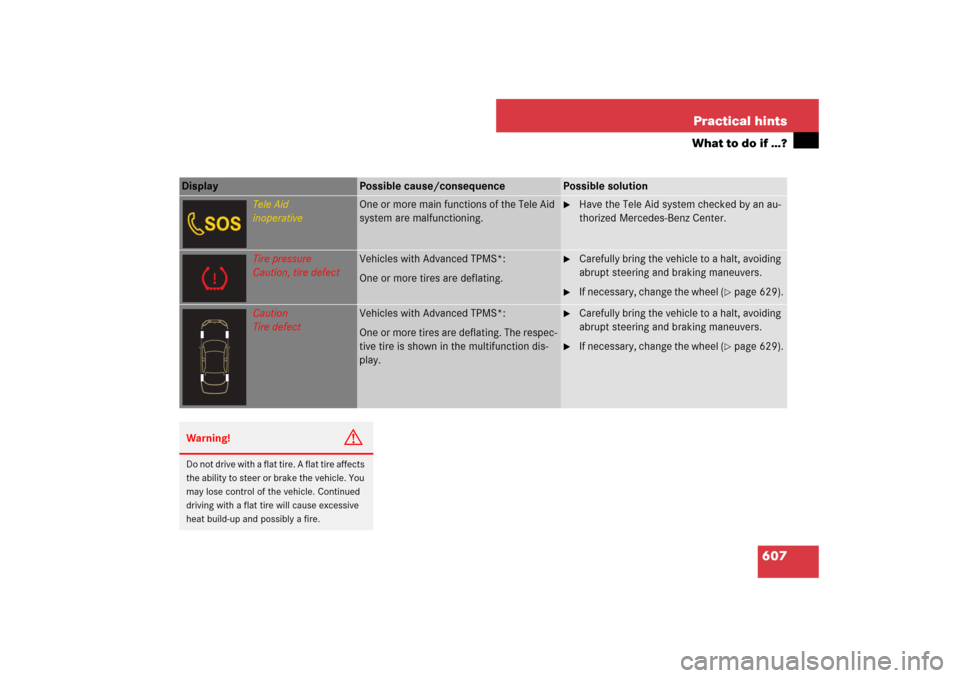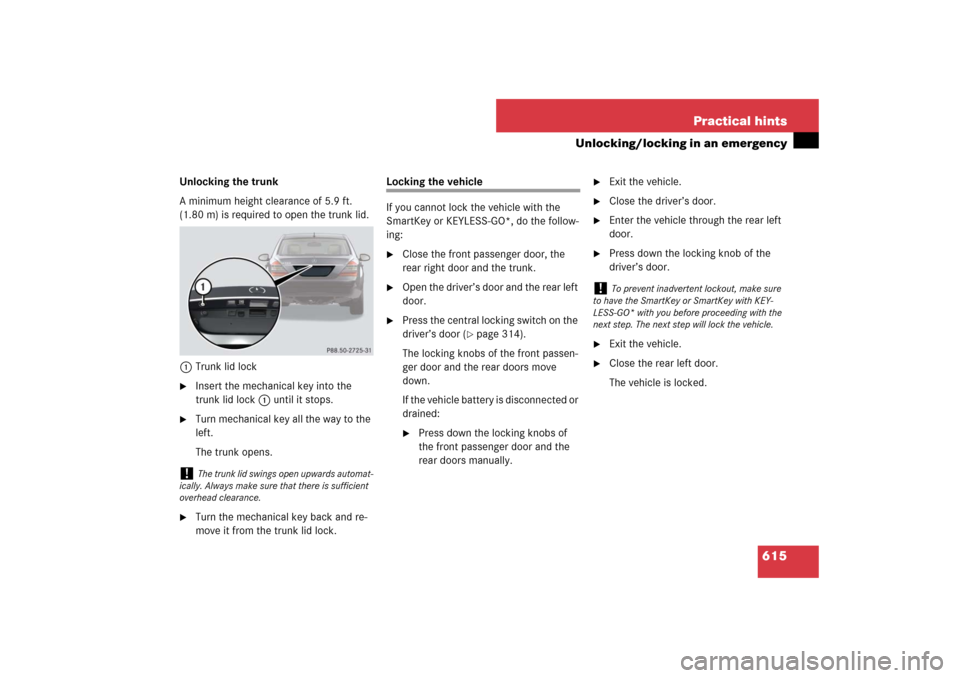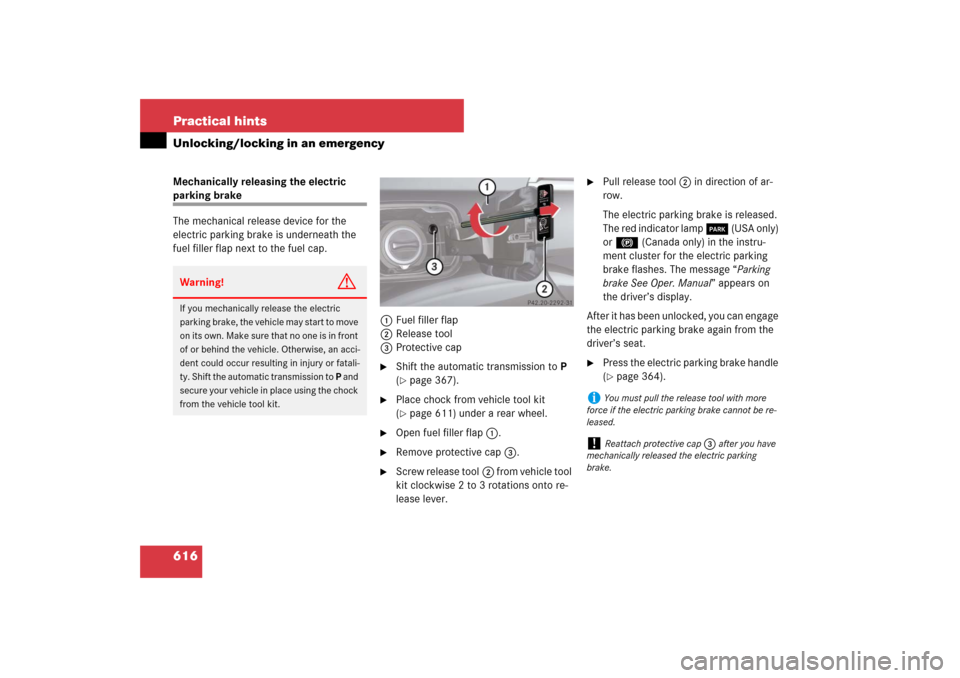Page 608 of 705

607 Practical hints
What to do if …?
Display
Possible cause/consequence
Possible solution
Tele Aid
inoperative
One or more main functions of the Tele Aid
system are malfunctioning.
�
Have the Tele Aid system checked by an au-
thorized Mercedes-Benz Center.
Tire pressure
Caution, tire defect
Vehicles with Advanced TPMS*:
One or more tires are deflating.
�
Carefully bring the vehicle to a halt, avoiding
abrupt steering and braking maneuvers.
�
If necessary, change the wheel (
�page 629).
Caution
Tire defect
Vehicles with Advanced TPMS*:
One or more tires are deflating. The respec-
tive tire is shown in the multifunction dis-
play.
�
Carefully bring the vehicle to a halt, avoiding
abrupt steering and braking maneuvers.
�
If necessary, change the wheel (
�page 629).
Warning!
G
Do not drive with a flat tire. A flat tire affects
the ability to steer or brake the vehicle. You
may lose control of the vehicle. Continued
driving with a flat tire will cause excessive
heat build-up and possibly a fire.
Page 609 of 705
608 Practical hintsWhat to do if …?Display
Possible cause/consequence
Possible solution
Tire pressure
Check tires
Vehicles with Advanced TPMS*:
The pressure is too low in one or more tires.
�
Carefully bring the vehicle to a halt, avoiding
abrupt steering and braking maneuvers.
�
Check and adjust tire inflation pressure as
required (
�page 514).
�
If necessary, change the wheel (
�page 514).
Check tires
Vehicles with Advanced TPMS*:
The pressure is too low in one or more tires.
The respective tire is shown in the multi-
function display.
�
Carefully bring the vehicle to a halt, avoiding
abrupt steering and braking maneuvers.
�
Check and adjust tire inflation pressure as
required (
�page 514).
�
If necessary, change the wheel (
�page 514).
Warning!
G
Do not drive with a flat tire. A flat tire affects
the ability to steer or brake the vehicle. You
may lose control of the vehicle. Continued
driving with a flat tire will cause excessive
heat build-up and possibly a fire.
Page 610 of 705
609 Practical hints
What to do if …?
Display
Possible cause/consequence
Possible solution
Wheel sensor(s)
missing
One or more sensors malfunction (e.g. bat-
tery in one or more wheel sensor is empty).
One or more wheels without wheel sensors
mounted (e.g. spare tire).
No pressure value is shown on the multi-
function display for the tire in question.
�
Have the Advanced TPMS* checked by an
authorized Mercedes-Benz Center.
�
Have the wheel sensors installed by an
authorized Mercedes-Benz Center.
The tire pressure for the respective tire is
shown in the multifunction display after a few
minutes driving.
Tire pressure
Please rectify
Vehicles with Advanced TPMS*:
The pressure is too low in one or more tires.
Or the tire pressures of the individual
wheels differ too radically from one anoth-
er.
�
Check and adjust tire inflation pressure as
required (
�page 514).
Page 611 of 705
610 Practical hintsWhat to do if …?Display
Possible cause/consequence
Possible solution
Shift to 'P'
You have attempted to turn off the engine
with the KEYLESS-GO* start/stop button
and opened the driver’s door with the auto-
matic transmission not shift to positionP.
�
Shift the automatic transmission toP
(�page 367).
or
�
Close the driver’s door.
You are driving with the trunk open.
�
Close the trunk (
�page 437).
Washer fluid,
please refill
The water level has dropped to approx.
1.1 US qts (1.0 l).
�
Add washer fluid (
�page 498).
Page 615 of 705
614 Practical hintsUnlocking/locking in an emergencyUnlocking the vehicle
If you are unable to unlock the vehicle with
the SmartKey or KEYLESS-GO*, open the
driver’s door and the trunk using the me-
chanical key. Removing the mechanical key
1Mechanical key locking tab
2Mechanical key
�
Move locking tab1 in the direction of
arrow.
�
Slide mechanical key2 out of the
housing.Unlocking the driver’s door
1Unlocking
2Mechanical key
�
Insert mechanical key2 into the driv-
er’s door lock until it stops.
�
Turn mechanical key2 counterclock-
wise to position1.
The driver’s door is unlocked.
�
Pull door handle quickly.
The locking knob moves up.
�
Turn back mechanical key2 and re-
move.
�
Pull door handle again.
i
Unlocking the driver’s door and/or the trunk
with the mechanical key will trigger the anti-theft
alarm system (
�page 75).
To cancel the alarm, insert the SmartKey or
SmartKey with KEYLESS-GO* in the starter
switch.
Page 616 of 705

615 Practical hints
Unlocking/locking in an emergency
Unlocking the trunk
A minimum height clearance of 5.9 ft.
(1.80 m) is required to open the trunk lid.
1Trunk lid lock�
Insert the mechanical key into the
trunk lid lock1 until it stops.
�
Turn mechanical key all the way to the
left.
The trunk opens.
�
Turn the mechanical key back and re-
move it from the trunk lid lock.
Locking the vehicle
If you cannot lock the vehicle with the
SmartKey or KEYLESS-GO*, do the follow-
ing:�
Close the front passenger door, the
rear right door and the trunk.
�
Open the driver’s door and the rear left
door.
�
Press the central locking switch on the
driver’s door (
�page 314).
The locking knobs of the front passen-
ger door and the rear doors move
down.
If the vehicle battery is disconnected or
drained:
�
Press down the locking knobs of
the front passenger door and the
rear doors manually.
�
Exit the vehicle.
�
Close the driver’s door.
�
Enter the vehicle through the rear left
door.
�
Press down the locking knob of the
driver’s door.
�
Exit the vehicle.
�
Close the rear left door.
The vehicle is locked.
!
The trunk lid swings open upwards automat-
ically. Always make sure that there is sufficient
overhead clearance.
!
To prevent inadvertent lockout, make sure
to have the SmartKey or SmartKey with KEY-
LESS-GO* with you before proceeding with the
next step. The next step will lock the vehicle.
Page 617 of 705

616 Practical hintsUnlocking/locking in an emergencyMechanically releasing the electric parking brake
The mechanical release device for the
electric parking brake is underneath the
fuel filler flap next to the fuel cap.
1Fuel filler flap
2Release tool
3Protective cap
�
Shift the automatic transmission to P
(�page 367).
�
Place chock from vehicle tool kit
(�page 611) under a rear wheel.
�
Open fuel filler flap1.
�
Remove protective cap3.
�
Screw release tool2 from vehicle tool
kit clockwise 2 to 3 rotations onto re-
lease lever.
�
Pull release tool2 in direction of ar-
row.
The electric parking brake is released.
The red indicator lamp 0 (USA only)
or ! (Canada only) in the instru-
ment cluster for the electric parking
brake flashes. The message “Parking
brake See Oper. Manual” appears on
the driver’s display.
After it has been unlocked, you can engage
the electric parking brake again from the
driver’s seat.
�
Press the electric parking brake handle
(�page 364).
Warning!
G
If you mechanically release the electric
parking brake, the vehicle may start to move
on its own. Make sure that no one is in front
of or behind the vehicle. Otherwise, an acci-
dent could occur resulting in injury or fatali-
ty. Shift the automatic transmission to P and
secure your vehicle in place using the chock
from the vehicle tool kit.
i
You must pull the release tool with more
force if the electric parking brake cannot be re-
leased.
!
Reattach protective cap
3
after you have
mechanically released the electric parking
brake.
Page 618 of 705
617 Practical hints
Opening/closing in an emergency
�Opening/closing in an emergency
Power tilt/sliding sunroof or panorama roof with power tilt/sliding panel*
You can open or close the tilt/sliding sun-
roof or tilt/sliding panel manually should
an electrical malfunction occur.
The drive mechanism is behind the left sun
visor.
1Cover�
Remove cover1.2Crank
�
Take crank2 from the Operator’s
Manual pouch.
�
Switch on the ignition (
�page 315).
�
Insert crank2 through the hole.
�
Turn crank2 clockwise to:�
slide roof panel/sunroof closed
�
raise roof panel/sunroof at the rear
�
Turn crank3 counterclockwise to:�
slide roof panel/sunroof open
�
lower roof panel/sunroof at the
rear
i
Turn crank2 slowly and smoothly.
The tilt/sliding sunroof (
�page 442) or tilt/slid-
ing panel (
�page 446) must be synchronized af-
ter being operated manually.